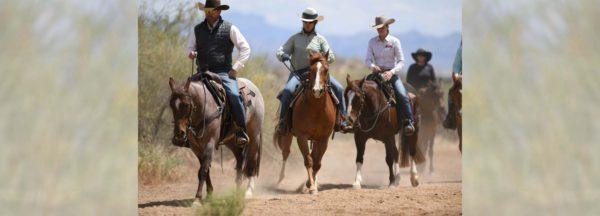Training Tip: Horse Won’t Walk on the Trail

Question: I have a Paso Fino that won’t stop running. I’ve tried running him until he is sweaty, but he still runs. I have tried making work look hard and standing still look easy, but he still goes. Please help. I can’t ever get him to walk, and I can never cool him down. – Catico
Answer: The first step is to make sure you’ve thoroughly taken your horse through the Fundamentals level of the Method, and since you’re riding him on the trail, the foundation trail exercises in the Fundamentals In Action on the Trail Series. Without having a proper foundation in place, you can’t expect your horse to relax and be calm on the trail.
If your horse is really hot and sensitive, when you begin the riding exercises in the Fundamentals Series, you may have to spend a week or more doing nothing but One Rein Stops until he learns to relax and slow down. Whenever I say this, people assume I’m joking or making an exaggeration. I’m not. I literally mean that you may spend training session after training session working on nothing but One Rein Stops until your horse understands the exercise. When he does, you’ll move on to the next exercise. Proper training takes the time that it takes.
There are some horses that are naturally really hot and nervous, and even after they’ve been through the Fundamentals and trail exercises, they’re still in a hurry to get everywhere. These horses require a little extra training and patience. As you discovered, encouraging these horses to run or letting them run in hopes that they’ll tire out doesn’t work. The fix is not to force the horse to calm down and relax, but to turn your idea to slow down into the horse’s idea.
You’ll do that by planning out a ride in which you can hustle his feet and then let him walk on a loose rein. At the ranch, we use rollback fences I put up around the property, but you can use any natural obstacle on the trail, such as bushes, trees, rocks, etc.
Warm your horse up and then put his feet to work. Practice rollbacks, trot the horse in serpentines, yield his hindquarters … anything we can think of to keep his feet moving and him guessing about what we’re going to ask him to do. As long as you’re hustling your horse’s feet and constantly changing directions, it doesn’t matter how you’re working the horse, just that you are assertively moving his feet. You can do serpentines, counterbend the horse, etc.
Work your horse for five to 10 minutes, depending on how hot it is, how athletic your horse is and how busy-minded he is. The hotter the temperature, the shorter the session, and the more athletic and busy-minded the horse is, the longer the session.
After that, put the horse on a loose rein and walk him down the trail. As a general rule, you want to let the horse walk for about five minutes between workouts. The walk is the relaxing part of the ride for the horse—he gets to be on a loose rein and get his air back. The key is to let the horse walk on a big, loose rein and not do any sort of training whatsoever on him. Hold the middle of the reins in one hand and just let him be.
After letting him walk for about five minutes, put his feet to work again. Hustle his feet for five to 10 minutes, and then walk him down the trail on a loose rein. Think of moving your horse’s feet like workout stations in the gym, where you have to do crunches, burpees or squats. How slowly would you walk to the next station if you knew what was in store for you? You’ll repeat this process at least five times. It’s important to keep at it until the horse is mentally and physically relaxed. In fact, for this lesson to really change the horse’s frame of mind so that he learns to relax and use the thinking side of his brain, you should practice these training sessions for five days in a row. You want to get that “relaxed and slow” mentality ingrained in the horse. Then you can go back to riding your horse on the trail as normal.
It’s important that for the first few sessions you not train on the horse at all except at the workout locations. You want it to be really clear for the horse: Regardless of where we’re going, it’s never a fun place to get to. It doesn’t matter which direction we go in or how far we go, there’s always hard work when we get there, so you might as well take your time and enjoy the downtime between. Horses are simple creatures, so you have to keep your training simple to make the most progress.
